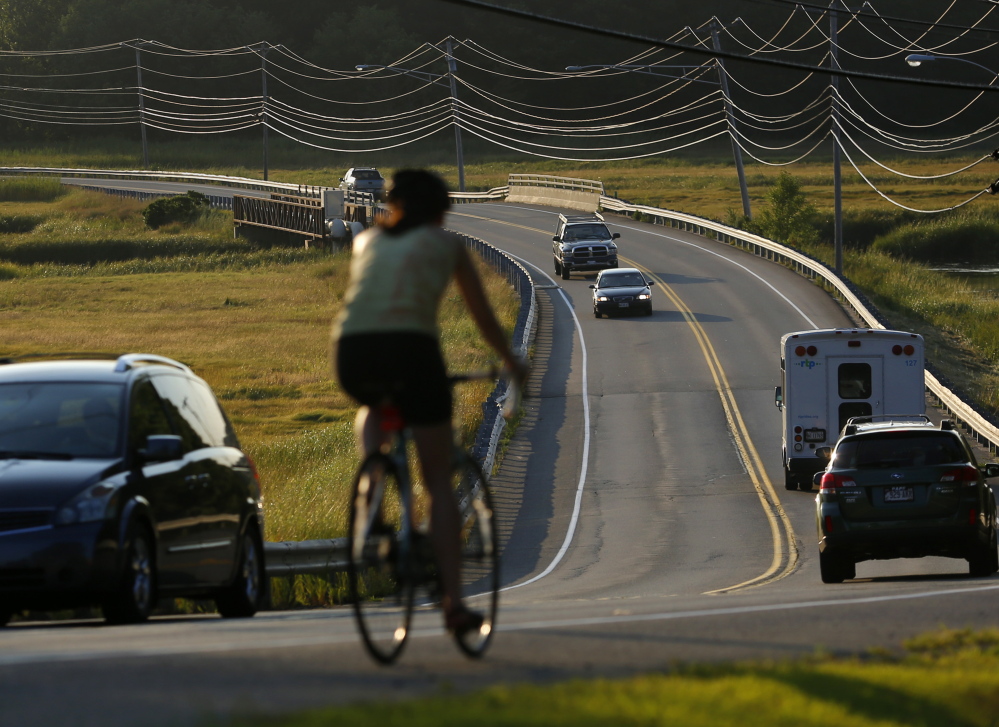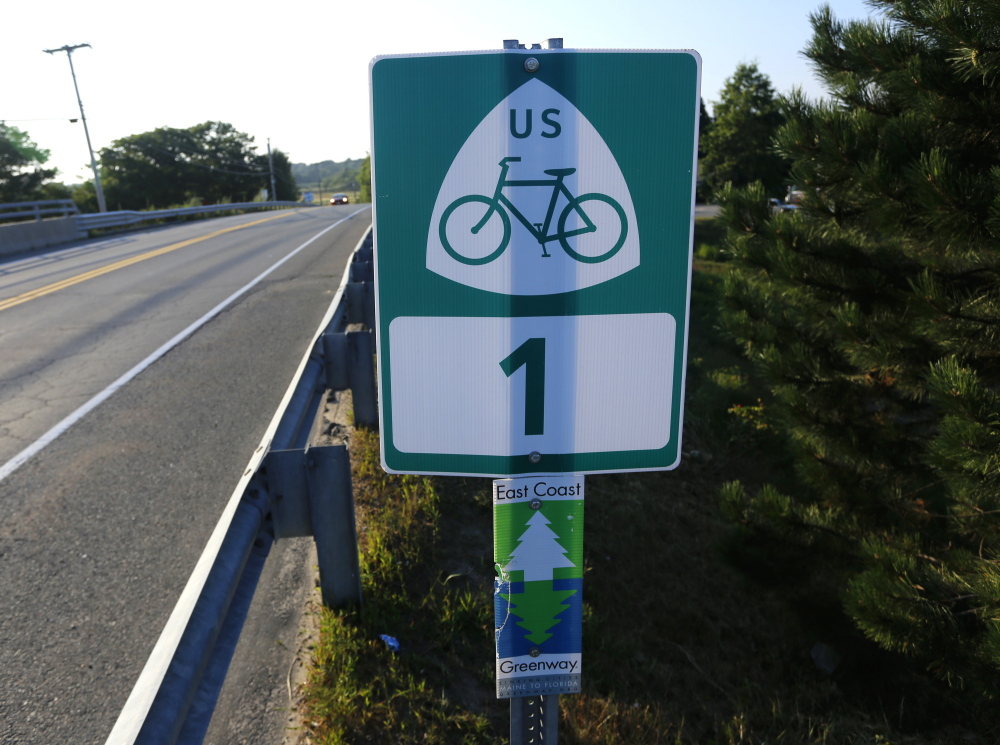Beginning this fall, state road crews will install signs marking the first interstate route in Maine intended solely for bicyclists.
U.S. Bike Route 1 will take cyclists from the Memorial Bridge in Kittery to the International Bridge in Calais. While the 397-mile route mostly follows the coast, it cuts inland to connect all of Maine’s major cities, including Lewiston, Augusta and Bangor. When the entire route is completed, cyclists will be able to follow it from Key West, Florida, to the Canada border.
Although the names are similar, the bike route mostly skirts the U.S. Route 1 highway in favor of safer and more scenic roads and trails. It diverges in two places from the East Coast Greenway (ECG). The route gives cyclists a choice of sticking to paved roads rather than riding on bumpy, off-road trails in Old Orchard Beach and parts of Hancock and Washington counties.
Along the way, riders will pass some of Maine’s most beautiful places, such as Scarborough Marsh, Portland’s Back Cove and the blueberry barrens of Washington County. Lucky cyclists could see moose, bald eagles and black bears; I’ve spotted all three in the Down East section of the route.
Cyclists will ride by the Old Orchard Beach Pier, the world’s largest globe in Yarmouth, Bates College in Lewiston, the Paul Bunyan statue in Bangor and several historic sites. I was particularly pleased to see that the route passes two of my favorite pie stops: Dysart’s in Hermon and Helen’s Restaurant in Machias.
Planning for a bicycle interstate along the East Coast began about 35 years ago. The goal was to provide an alternative to U.S. Highway 1, with its strip malls, traffic and often-dangerous cycling conditions. But the effort stalled because of the enormous work involved.
“It’s easy to draw a line on a map,” said Tony Barrett, a bicycling advocate from Harpswell. Winning support from local communities, vetting and marking the route proved much more difficult, said Barrett, who’s been involved in the project for more than 15 years.
By the 1990s, the ECG Alliance developed plans for an off-road route along the East Coast. But building that network of trails through 15 states would take many decades. Bicyclists needed an alternative route using existing roads and trails.
John Balicki, Maine’s former bicycle-pedestrian coordinator, played a key role in moving the project forward. Balicki, who worked for the Maine Department of Transportation (DOT), helped organize 21 meetings in 1999 and 2000 to get ideas from the public about where the route should go.
At each meeting, Balicki recalled, “We threw down a map and said, ‘How do we get from here to there?’ ”
Local cyclists, trail managers, town officials and others gave their opinions. They had some heated debates about whether to lengthen the route by including places such as Pemaquid Point that offer spectacular views.
Some town officials insisted on having U.S. Bike Route 1 go through their downtowns to bring more business there. In other cases, cyclists wanted to include a favorite lobster restaurant or an ice cream shop.
Hundreds of people helped develop the route that was approved by the Maine Department of Transportation. Maine’s inclusive approach became a model for other states.
Maine DOT made detailed cue sheets for the route, listing nearby parks, grocery stores and other businesses, campgrounds, motels, bus and train stations and public toilets. Maps can be found at maine.gov/mdot/bikeped/.
While U.S. Bike Route 1 goes inland between Brunswick and Bucksport, an alternative (U.S. Bike Route 1A) hugs the coast the whole way.
Official U.S. bicycle routes must go through a laborious approval process, similar to the one for interstate highways. The American Association of State Highway and Transportation Officials approved Maine’s plans for U.S. Bike Route 1 in 2011.
Marking the route has taken more than a decade. “These signs have been one of the longest-running projects in government history,” Balicki quipped. One reason for the delay was the time it took for the federal government to develop standardized signs for national bicycle routes.
Meanwhile, a Maine committee has continued to tweak the route. When new, off-road trails open, they may be added.
Trail advocates now are trying to secure funding to connect the Eastern Trail in Scarborough and the Greenbelt trail in South Portland. That would improve U.S. Bike Route 1 by eliminating a dangerous crossing of Black Point Road in Scarborough.
The U.S. Bike Route 1 signs will make it easier for long-distance cyclists to traverse the state. And they will alert motorists that cyclists are on the road. Having an official bicycle route also should help Maine attract more cycling tourists.
“I think it’s really significant,” Balicki said. “It recognizes that bicycling is part of our national transportation system, the same as motoring is.”
We owe a big thank you to Balicki, Barrett and all of the other Mainers who spent years helping to make U.S. Bike Route 1 a reality.
Shoshana Hoose is a freelance writer who bicycles in Greater Portland and beyond. Contact her at shoshanahoose@gmail.com.
Copy the Story LinkSend questions/comments to the editors.




Success. Please wait for the page to reload. If the page does not reload within 5 seconds, please refresh the page.
Enter your email and password to access comments.
Hi, to comment on stories you must . This profile is in addition to your subscription and website login.
Already have a commenting profile? .
Invalid username/password.
Please check your email to confirm and complete your registration.
Only subscribers are eligible to post comments. Please subscribe or login first for digital access. Here’s why.
Use the form below to reset your password. When you've submitted your account email, we will send an email with a reset code.